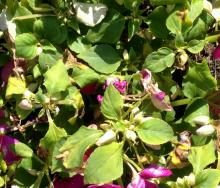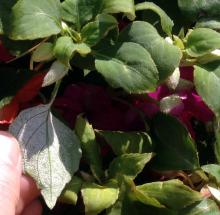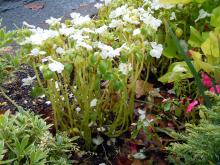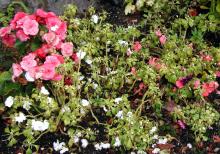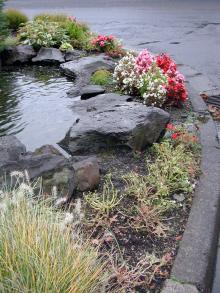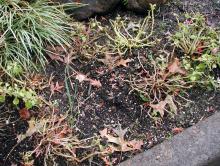Cause Plasmopara destructor is a host-specific, fungus-like organism known as an oomycete, or water mold. There have been sporadic reports in greenhouses since 2004, but it was not until summer 2011 that regional outbreaks of this disease were seen for the first time in landscape beds and container plantings in North America. The disease was found in landscapes in Oregon and Washington since 2012. Impatiens business dropped 50% to 60% due to this disease alone.
Oospores survive in plant debris and are released into the soil or media as infected stems decay. These resting spores can survive in the soil for years. Oospores produce sporangia, which are then splashed by rain or carried by wind to new plants. These airborne spores may find their way into greenhouses as well as landscapes. Infected plugs brought into the greenhouse can also be a source of this pathogen. Young plants and immature plant tissues are especially susceptible to infection. Once on the plant, sporangia may germinate directly or release swimming zoospores. Zoospores can swim in moisture on the leaf surface, encyst, then germinate and penetrate the leaf tissue through the stomata by means of a germ tube. Warm temperatures and long periods of leaf wetness (3 to 12 hours) are favorable for infection. The time from infection to the appearance of new sporangia varies from 5 to 14 days depending on the age of plant tissue, temperature, and humidity. In response to changes in light, temperature, and/or humidity, the new sporangia are dislodged and can easily become airborne or splashed by rain or water to other leaves and distant plants. Complete plant loss can occur in as little as 4 to 6 weeks. There is no evidence of seedborne transmission. The disease is generally found late summer to early fall.
Most cultivars and intraspecific hybrids of I. walleriana are susceptible to impatiens downy mildew. There are several resistant cultivars including Beacon and Imara XDR. Although resistant, these cultivars are not immune and need protection during production. A few species of wild impatiens are also hosts of this disease, but there are no other known hosts. New Guinea impatiens (Impatiens hawkerii) are highly tolerant and have been successfully grown in greenhouses and landscapes even under high disease pressure.
Symptoms A light-green yellowing or stippling of infected leaves develops first. Very subtle gray lines or markings are sometimes observed on the top of the leaf. Infected leaves may curl downward at the edges, but generally this is a more advanced symptom of infection. Leaf symptoms are often first observed on the younger leaves or terminal growth. Seedling cotyledons are also highly susceptible. Plants infected at an early stage of development may be stunted in both height and leaf size, yet may show no visible signs of sporulation. Could be confused with spray injury, nutritional imbalance, chilling or spider mites.
A white, downy-like growth (sporangia) may be visible on the underside of infected leaves during cool and moist or humid conditions. Eventually leaves and flowers will drop, resulting in bare stems with only a few tiny, yellow leaves remaining. This symptom is more likely to be observed in a landscape setting and may be blamed on deer or rabbit damage. The remaining green stems then collapse.
Scouting Frequent scouting of the greenhouse crop, looking for early leaf symptoms (subtle stippling or yellowing), is critical for early detection. Turn leaves over to observe the undersides for the white, downy growth. Look for symptoms in the landscape late summer and into fall.
Cultural control Aggressive scouting, environmental controls, and good sanitation will help manage this disease in the greenhouse.
- Avoid the introduction of diseased plant material. Inspect liners and plugs on delivery. Segregate any newly arriving material to observe for symptoms.
- Grow vegetative cuttings and seed-grown plants in separate greenhouses to limit cross-contamination.
- Reduce greenhouse humidity and limit leaf moisture, especially at night, to limit secondary spread.
- Provide good air movement through plant spacing and horizontal airflow.
- Irrigate when leaves will dry most quickly to help minimize leaf wetness and humidity.
- Promptly bag and seal symptomatic plants and any fallen leaves or petals before carrying them out of the greenhouse. Before planting in the landscape, and at the end of every season, remove as much plant debris as possible including leaves, stems, and roots.
- Rotate landscape planting beds each year so that impatiens are not grown in the same place for 3 or 4 years.
- Consider New Guinea impatiens, begonias, coleus, or other alternative bedding plants where impatiens were grown the previous year.
- Grow resistant cultivars.
Chemical control Must use fungicides in conjunction with cultural controls and before the disease is found. Apply fungicides preventively on a 7- to 14-day interval (depending on material) for maximum efficacy. Scouting first then spraying is an ineffective tactic however, infected plants cannot be saved. Drench applications have longer efficacy than foliar applications. Downy mildew resistant to several active ingredients have been found in various locations. Alternate or tank-mix products from different groups that have different modes of action. Limit the use of any one group during crop production. Although resistant, 'Beacon' and 'Imara XDR' are not immune and need chemical protection during production.
- Adorn at 1 to 4 fl oz/100 gal water plus another fungicide. Impatiens is NOT specifically mentioned on the label but can legally be used. Has some eradicant activity. Saturate the root zone thoroughly when drenching. Group 43 fungicide. 12-hr reentry.
- Agri-Fos at 1.25 to 2.5 quarts/100 gal water. Saturate the root zone thoroughly when drenching. WA only. Group P7 fungicide. 4-hr reentry.
- Aliette at 1.25 to 4 lb/100 gal water. Do not use with adjuvants. Has not been effective. Group P7 fungicide. 24-hr reentry.
- Areca at 2.5 lb/100 gal water as a foliar application. Group P7 fungicide. 12-hr reentry.
- Disarm 480 SC at 1 to 4 fl oz/100 gal water. Group 11 fungicide. 12-hr reentry.
- Fenstop at 7 to 14 fl oz/100 gal water. Higher rate may be phytotoxic to young plants. For greenhouse use only. Impatiens is NOT specifically mentioned on the label but can legally be used. Has some eradicant activity. Group 11 fungicide. 12-hr reentry.
- Heritage at 2 oz/100 gal water plus a non-silicone-based wetter sticker. Good preventative activity. Group 11 fungicide. 4-hr reentry.
- KleenGrow at 6 to 38 fl oz/100 gal water. 48-hr reentry.
- Mancozeb-based products can be used as mixing partners. Limit total applications as these products can build up on plants causing stunting and yellowing. Group M3 fungicides. 24-hr reentry.
- Fore 80 WP at 1.5 lb/100 gal water plus a spreader-sticker.
- Protect DF at 1 to 2 lb/100 gal water plus 2 to 4 oz spreader-sticker.
- Mefenoxam 2 AQ at 0.49 to 0.98 fl oz/100 gal water plus another fungicide with a different mode of action. Group 4 fungicide. 48-hr reentry.
- Micora at 4 to 8 fl oz/100 gal water. Group 40 fungicide. 4-hr reentry.
- Monterey Garden Phos at 0.5 to 1.1 fl oz/gal water as a foliar spray. Also labeled for soil drench, see label for details. Group P7 fungicide. H
- Orkestra at 10 fl oz/100 gal water. May discolor flowers if sprayed directly. Group 7 + 11 fungicide. 12-hr reentry.
- Orvego at 11 to 14 fl oz/100 gal water. Group 40 + 45 fungicide. 12-hr reentry.
- OxiPhos at 1.3 to 4 quarts/100 gal water as a foliar spray. Group P7 fungicide. 4-hr reentry.
- Pageant at 12 to 18 oz/100 gal water. May cause discoloration when applied to blooms. Do not use with organosilicone-based adjuvants. Group 7 + 11 fungicide. 12-hr reentry.
- Segovis at 0.6 to 3.2 fl oz/100 gal water. Group 49 fungicide. 4-hr reentry.
- Segway SC at 2.1 to 3.5 fl oz/100 gal water. Drench rate is based on pot diameter. Impatiens is NOT specifically mentioned on the label but can legally be used. Group 21 fungicide. 12-hr reentry.
- Stature SC at 6.4 to 12.8 fl oz/100 gal water. Has some eradicant activity. Group 40 fungicide. 12-hr reentry.
- Subdue MAXX at 0.25 fl oz/100 gal water as a seeding drench or at 1 fl oz/100 gal water plus another fungicide as a foliar spray. Subdue GR is registered for landscape use. Group 4 fungicide. 48-hr reentry.
- Zonix at 45 to 76 fl oz/100 gal water. Can be sprayed on crop or injected into irrigation system. Short residual so may have to be used frequently for adequate results. 4-hr reentry.
References Salgado-Salazar, C., Castroagudín, V. L., LeBlanc, N. R., Daughtrey, M. L., Hausbeck, M. K., Palmer, C. L., Shishkoff, N., Warfield, C. and Crouch, J. A. 2023. The Impatiens Downy Mildew Epidemic in the United States Is Caused by New, Introgressed Lineages of Plasmopara destructor with Prominent Genotypic Diversity and High Evolutionary Potential. Plant Disease, 107:2027-2038.
Warfield, C.Y. 2012. Downy mildew of impatiens. Grower talks, 2012.

